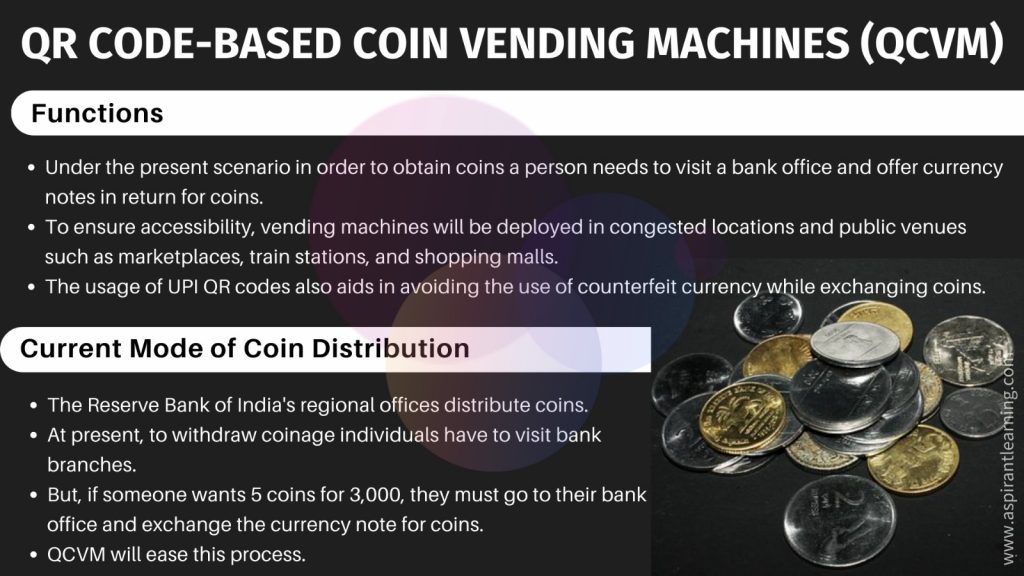News Highlight
Reserve Bank of India’s new pilot project on coin vending machines.
Key Takeaway
- RBI Governor had remarked during the recent Monetary Policy Committee (MPC) address that the apex financial regulator, in partnership with banks.
- It would undertake a pilot project to evaluate the operation of a coin vending machine based on QR codes.
QR code-based Coin Vending Machine (QCVM)
- About
- A person will have to approach the bank branch to withdraw coins.
- The QR code-based coin vending machine (QCVM) is designed to dispense coins like currency notes that can be withdrawn from ATMs.
- Coins can be withdrawn from vending machines with the Unified Payments Interface (UPI) QR code.
- Coins in denominations ranging from Rs 1 to Rs 20 will be available in QCVM.
- Furthermore, the RBI intends to offer the product in 19 venues across 12 cities.
- Because the implementation would begin with a pilot launch, just a few banks may be involved in the early phases.
Advantages of QCVM
- The main goal is to improve cash availability at the last mile across all categories, including the mass market.
- Because the interface is UPI, linked to the person’s bank account, the value of coins withdrawn is directly debited from the bank account.
- It eliminates the need to exchange notes for coins, saving time for bank branches and customers.
- In addition, that will improve coin accessibility.
- With cash sales still essential at tiny shops, QCVM could help vendors when coins are scarce.
Disadvantages of QCVM
- Banks may incur additional fees for replenishing these vending machines through third-party agents.
- A coin costs Rs 1.11 on average to mint.
- From a financial standpoint, adding another layer for setting up and distributing currency through vending machines could be more appealing.
- Because the government’s goal is to increase the popularity and reach of digital payments, QCVM may be detrimental.
- QCVM appears to oppose e-Rupee retail’s goal.
- It is to lower currency minting/printing costs and gradually replace physical currencies with digital currencies.

Unified Payments Interface (UPI)
- About
- It is a more advanced form of Immediate Payment Service (IMPS), a 24-hour funds transfer service designed to make cashless payments faster, easier, and more seamless.
- UPI is a system that integrates;
- Several bank accounts into a single mobile app (of any participating bank)
- Combining several banking features
- Smooth fund routing
- Merchant payments are under one umbrella.
- UPI is now the most popular of the National Payments Corporation of India (NPCI)-managed systems, which also include;
- The National Automated Clearing House (NACH)
- Immediate Payment Service (IMPS)
- Aadhaar-enabled Payment System (AePS)
- Bharat Bill Payment System (BBPS)
- RuPay and others.
- Today’s top UPI apps include PhonePe, Paytm, Google Pay, Amazon Pay and BHIM, the latter being the Government offering.
- As part of an arrangement, India’s UPI would be linked to Singapore’s PayNow.
- In 2016, NPCI launched UPI with 21 member banks.
National Payment Corporation of India (NPCI)
- About
- NPCI is an umbrella corporation operating retail payment settlement services in India.
- The RBI and the Indian Banks’ Association (IBA) founded NPCI under the Payment and Settlement Systems Act of 2007.
- In addition, it is to create a substantial Payment and Settlement Infrastructure in India.
- Under the Companies Act of 1956, NPCI was established as a non-profit organisation (Now the Companies Act of 2013).
- Functions
- NPCI handles all retail payments in India.
- The RuPay card network, India’s domestic card network, is operated by NPCI.
- The Universal Payments Interface (UPI) is a real-time payment system that enables rapid payments between bank accounts.
- NPCI acts as National Automated Clearing House (NACH), an offline web-based system that handles bulk push and pulls transactions.
- NACH provides an electronic mandate platform for corporates and banks to register mandates, allowing paperless collection operations.
- It supports both account and Aadhaar-based transactions.
- Furthermore, NPCI manages the National Financial Switch (NFS).
Pic Courtesy: The Hindu
Content Source: The Hindu



